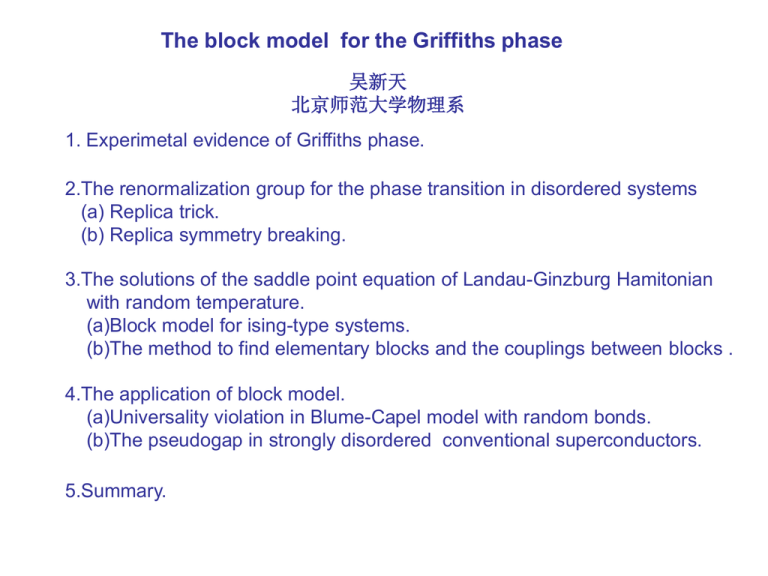Block model
advertisement

The block model for the Griffiths phase
吴新天
北京师范大学物理系
1. Experimetal evidence of Griffiths phase.
2.The renormalization group for the phase transition in disordered systems
(a) Replica trick.
(b) Replica symmetry breaking.
3.The solutions of the saddle point equation of Landau-Ginzburg Hamitonian
with random temperature.
(a)Block model for ising-type systems.
(b)The method to find elementary blocks and the couplings between blocks .
4.The application of block model.
(a)Universality violation in Blume-Capel model with random bonds.
(b)The pseudogap in strongly disordered conventional superconductors.
5.Summary.
Griffiths Phase
R. B. Griffiths, Phys. Rev. Lett. 23, 17 (1969).
A. J. Bray, Phys. Rev. Lett. 59, 586 (1987).
(h ) is singular
at h 0
"compact" cluster of occupied sites
The probability of these rare regions are proportional to
p
L
d
exp(L ln p)
d
?
The Griffiths singularities are
probably unobservable in experiments.
Roton at the temperature above the superfluid transition
Tc=0.725 K. Specifically, we observe a welldefined roton peak at temperature T>Tc in
Geltech where s 0 as observed in a
torsional oscillator experiment. Since the
existence of well-defined excitations at higher
wave vectors above the phonon (sound)
region depends on the existence of a Bose–
Einstein condensate (BEC), the observation
of a well-defined roton peak above Tc
suggests that there is Bose condensation
above Tc in Geltech.
Dynamic structure factor of
liquid 4He in Geltechl at the
roton wave vector at
temperatures as shown.
O. Plantevin, et al, Phys. Rev. B, 65 (2002) 224505.
This phase is characterized by the
coexistence of ferromagnetic entities within
the globally paramagnetic phase far above
the magnetic ordering temperature.
Tc=175K, below which the long range
order exists.
FMR: Ferromagnetic Resonance.
J. Deisenhofer, et. al, Phys. Rev. Lett. 95, 257202 (2005).
Griffiths singularities and magnetoresistive manganites
Deviation from the usual
Curie-Weiss law.
Anomalous critical exponents.
M B Salamon and S H Chun, Phys. Rev. B, 68, 014411 (2003).
Nature Physics, Vol. 3, p248 (2007)
ISSN 0021-3640, JETP Letters, 2007, Vol. 85, No. 1, pp. 51–54.
Landau-Ginzburg Hamiltonian with random temperature
In order to describe the phase transition in the quenched disordered systems,
Landau-Ginzburg Hamiltonian with random temperature is usually used.
1
1
g 4
~
2
2
H d x{ | (x) | (t t (x)) (x) (x)}
2
2
4
D
where
t ~
t (x) (T Tc (x)) / Tc (x) , and Tc (x) is the local critical
temperature.
Its saddle point equation is given by
2 (x) (t ~
t (x)) (x) g 3 (x) 0
For the pure system, it is obvious that above Tc, the saddle point solution
is zero. However in the early stage of studying the disordered systems, it is
still assumed that the saddle point solution is zero above Tc.
Replica trick
Consider the short-range correlated disorder
~
t (x)~
t (y ) av 8u0 (x y )
The probability of random temerperature is given by
P({~
t (x)}) C exp[(~
t (x))2 / 16u0 ]
x
The averaged free energy is given by
F ln z av P({~
t ( x)}) D~
t ln( De H )
Using the identity equation
z n 1
ln z lim
n 0
n
F ln z av lim( D exp[ H eff ] 1) / n
We can get
n0
The effective Hamiltonian is given by
n
H eff
n
n
1
1
2
2
4
d x{[ | (x) | t ( (x)) g ( (x)) u0 ( (x))2 ( (x))2 )
2
1 2
1 1
D
A weinrib and B I Halperin, Phys. Rev. B, 27 (1983) 413.
Replica symmetry breaking
In 1995, Dotsenko et. al proposed that they should be nonzero saddle point
solutions above the critical temeprature. Consider the saddle point equation
2 (t ~
t (x)) g 3 0
For
t u0 , there are some regions t ~t (x) 0
solution can be nonzero. If the size of the region is
reduced temperature is
~ ( x)
, where the saddle point
L0
, the average of
. The solution is given by
i (x) ~ (x) / g , ~ (x) 0
There should be many isolated islands. Consider
N
such isolated islands,
There should be 2 N solutions
N
i i (x) , i 1
i 1
V. S. Dotsenko, et al, J. Phys. A: Math. & Gen. , 28 (1995) 3093
Considering the solution
i (x)
should have some deviation from
~i (x) / g
They proposed that the solutions obey the following distribution
Where
1
P({ (x)}) exp[ 2 d D x(( i (x) 2 0i (x) 2 ) 2 ]
i
2
0i (x) ~i (x) / g
So, with the replica trick and some theory of spin glass, they obtained an effective
Hamitonian with replica symmetry breaking
H eff
1
1
2
d x{ [ | (x) | t ( (x)) 2
1 2
2
D
n
n
n
g ( (x)) 2 ( (x)) 2 }
1 1
Parameterizing
g
with Parisi ansartz, the renorlization group is applied to the
above Hamiltonian. However it is shown that the replica symmetry breaking is irrelevant.
Wu X T, 1998 Physica A 251 (1998) 309.
A. A. Fedorenko, J. Phys. A : Math. & Gen., 36 (2003) 1239.
The numerical solutions on the saddle point equation of
Landau-Ginzburg Hamiltonian with random temperature
For the phase transition in the quenched disordered systems, we consider the
Landau-Ginzburg Hamiltonian with random temperature. Its saddle point equation
Is given by
~
2
3
(x) (t t (x)) (x) g (x) 0
~(x) (T T (x)) / T (x) , and
Tc (x) is the local critical
c
c
where t t
temperature
In order to solve the saddle point equation numerically, we model the random
temperature as follows: the system is divided into cells with the same size l
and each cell has reduced temperature, that is
~
t (x) ~
ti , x ith cell
and the distribution of the random temperature is given by
~
1
( t i )2
P( t i )
exp[ 2 ]
2
2
~
Obviously the temperatures in different blocks are not correlated, the correlation
length of the disorder is l .
The following figure shows a typical solution of the two-dimensional
saddle point equation with random temperature for t 0 and l 1, 25 1 .
Before our work, the saddle point equation has not been studied in detail
although there are some qualitative arguments on it.
X. T. Wu and K. Yamada, J. Phys. A: Math. & Gen., 37 (2004) 3363
X. T. Wu, Phys. Rev. B 71, 174204 (2005)
An example of excited state solution in two dimension
This is a ground state solution for
certain realization of random
temperature. At the green part the
order parameter is very small and
near zero. At the blue part, the order
parameter is nonzero and positive.
The solution has the same sign over
the whole system.
l 2 25, t 0.98
This is an excited state solution for
the same realization of random
temperature as the above ground
state solution. At the green part the
order parameter is very small. At the
blue part the order parameter is
positive, ant at the red part it is
negative. The curves separating the
negative region and the positive
region are domain wall, at which the
order parameter changes sign.
Block model
In the system shown in last page, there are 6 locally ordered regions
(LOR). It can be shown that every LOR can take positive or negative
sign arbitrarily for the saddle point solutions. Therefore there are
26 64 states, two ground states and 62 excited states. We can
assign every LOR a variable i 1 , and use the set of variables
{ 1 , 2 , 3 , 4 , 5 , 6 } to label the states. On the saddle point level, in
which the fluctuation around the saddle point solutions are neglected, the
partition function is given by
64
Z e FI
I 1
The free energy of each states is given by
FI
1
4
D
g
(
x
)
d
x
I
4
The free energy difference between the excited state and ground state is given by
Fe Fg
1
4
4
D
g
(
(
x
)
(
x
))
d
x
e
g
4
Consider two adjoining LORs labeled by 1 and 2. If they have the same signs,
there is no domain wall between them. Otherwise there is a segment of
domain wall between them. Assuming the free-energy increase due to this
segment is K12 . Then for these two LORs, whether there is a segment of
domain wall between them or not , the free-energy increase due to these two
wells can be given by K12 ( 1 2 1) / 2
. Therefore the free energy
difference between an excited state and the ground state can be written
Approximately
F F K ( 1) / 2
I
g
ij
i
j
ij
The partition function becomes Z e
Fg ij J ij / 2
e
ij Kij i j / 2
I
1
2
1
2
X. T. Wu, Phys. Rev. B 79, 184208 (2009) .
This is also valid for multi-compenent spin systems, for example, XY-model.
Xintian Wu, Physica A, 391 (2012) 6247 .
How to find the elementary block and calculate the coupling between blocks
The method of opening windows.
x(,0y)
x0 x x0 sw
1,
y0 y y0 sw
other cases
1,
Domain walls around four elementary blocks
obtained with opening windows.
From
we get
f1 F1 Fg , f 2 F2 Fg and f12 F12 Fg
K12 ( f1 f 2 f12 ) / 2
Homogeneous and inhomogeneous phase transitions in the Blume-Capel
model with random bonds, X. T. Wu, PRE 82, 010101R (2010)
Universality violation in Blume-Capel model with random bond
The Hamiltonian of Blume-Capel model with random bond is given by
1
J r ,r r r r2
2 r ,
r
x, y
r 1,0 . The distribution of the bonds is
H
Where
1
1
P( J ) ( J J1 ) ( J J 2 ) and
2
2
( J1 J 2 ) / 2 1, J1 / J 2 r
8
3
ln
2
In the MF approximation for the pure model, the tricritical point t
, t
3
4
For t the phase transition is first order, otherwise is second order.
In the recent MC simulation, for both 1.0, r 3 / 5 and 1.9, r 1 / 7
the phase transition are second order. Moreover the critical exponents are
different. For the former, it has 1.0 ; for the latter, it has 1.35 .
A. Malakis, et. al , Phys. Rev. E 79, 011125 (2009).
Homogeneous and inhomogeneous phase transitions in the Blume-Capel
model with random bonds
Using the method mentioned above,
we can get the coupling between blocks.
The left figure is the distributions of the
couplings between blocks.
For 1.9, r 1 / 7 , the distribution is
exponential. The phase transition should
be percolation like. Then 1.35 .
For 1.0, r 3 / 5 , the distribution is
Gaussian. The phase transition should
be homogeneous. Then 1.0 .
X. T. Wu, PRE 82, 010101R (2010)
Pseudogap in disordered conventional superconductors
It is found that local superconductivity survives across the disorder-driven
superconductorinsulator transition.
Inhomogeneities of the
Superconducting gap.
Even in the insulating phase
where Tc=0, the average
superconducting gap still survives.
Disorder-Induced Inhomogeneities of the Superconducting State Close to the
Superconductor-Insulator Transition, B. Sace´pe´, et. al. , PRL 101, 157006
(2008)
Tunneling measurements reveal that for films with large disorder the superconducting
transition temperature is not associated with a vanishing of the superconducting
energy gap.
Above Tc, the system is peudogapped?
kF l ~ 6
k F l ~ 2.3
k F l ~ 1.4
Tunneling studies in a homogeneously disordered s-wave superconductor: NbN
S. P. Chockalingam, et. al., PRB 79, 094509 (2009)
We start from the negative-U hubbard model with site disorder
H t
ˆ
ˆ
ˆ
(
c
c
c
i, j, j, cˆi, ) ( i )nˆi | U | nˆinˆi
i , j ,
i
i
The random potential i is chosen independently at each site from a uniform
distribution . The BdG Hamiltonian is gvien by
Where
Introducing Bogliubov transformation to diagonalize the Hamiltonian
The free energy of each state is given by
According to Block model, the free energy of each state is approximately given by
The coupling distribution at different temperature for different disorder strength
2
=2.0
=4.0
0.6
PK
Pf
=4.0
0.4
=6.0 P
f
=10.0 0.2
0.3
0.2
PK
0.1
0.0
0.3
1
0
5
f
10
0.0
15
0
10
f
(b)
(a)
0.0
0.0
1.5
100
3.0
K
4.5
0.1
2
PK 1
0
f
5
10
4
K
10
PK 1
0.0
0
0
100
=4.0
0.8
=8.0 P
f
=16.0
0.4
10
20
0.1
6
0.4
Pf
0.2
0.0
0
f
10
20
0.01
0.01
0
(c)
(d)
1E-3
1
2
K
3
4
0
2
4
K
6
8
10
The distribution of couplings between neighbored elementary blocks and free
energy of elementary blocks (insets). The disorder strength is V=0.5,1.0,1.5,2.0
for (a),(b),(c), and (d) respectively. Recall the formula
f I K IJ , where
J
J labels the nearest neighbors of I .
Weak disorder
Strong disorder
T-evolutions of the local
tunnelling conductance G
characterized by the
presence (a) or absence (b)
of superconducting
coherent peaks.
Benjamin Sacépé, et. al, Nature Physics 7 (2011) 239.
Weak disorder
V0 0.5
1.6,2.0,4.0
Strong disorder
V0 1.5
1.6,2.0,4.0
One-particle density of states (DOS)
defined in termsof the BdG eigenvalues
X T Wu and R Ikeda, PRB 83, 104517 (2011)
The phase diagram
1. At the temperature of superconductivity phase transition, the
the energy gap is not zero.
2. The ratio
Egap / Tc
increases at strong disorder.
X T Wu and R Ikeda, PRB 83, 104517 (2011)
Summary
The block model for the Griffiths phase is proposed at the saddle point level.
It contains three basic points:
1.The systems is self-orgnized into blocks. The size of blocks depends on the
the correlation and strength of disorder.
2. The blocks are coupled with each other and behave like superspins. The
effective Hamiltonians are spin models with random bonds.
3. The couplings between elementary blocks can be obtained with the method
of opening windows.
These results are potentially valid for some systems, for example, conventional
superconductors, of which the pure systems can be described by mean-field
theory and their critical regimes are too small to be observed in experiments.
Of course, the further study on how the fluctuations about these solutions
renormalize them are worth. The fluctuation may change the block size and
The coupling between blocks.








